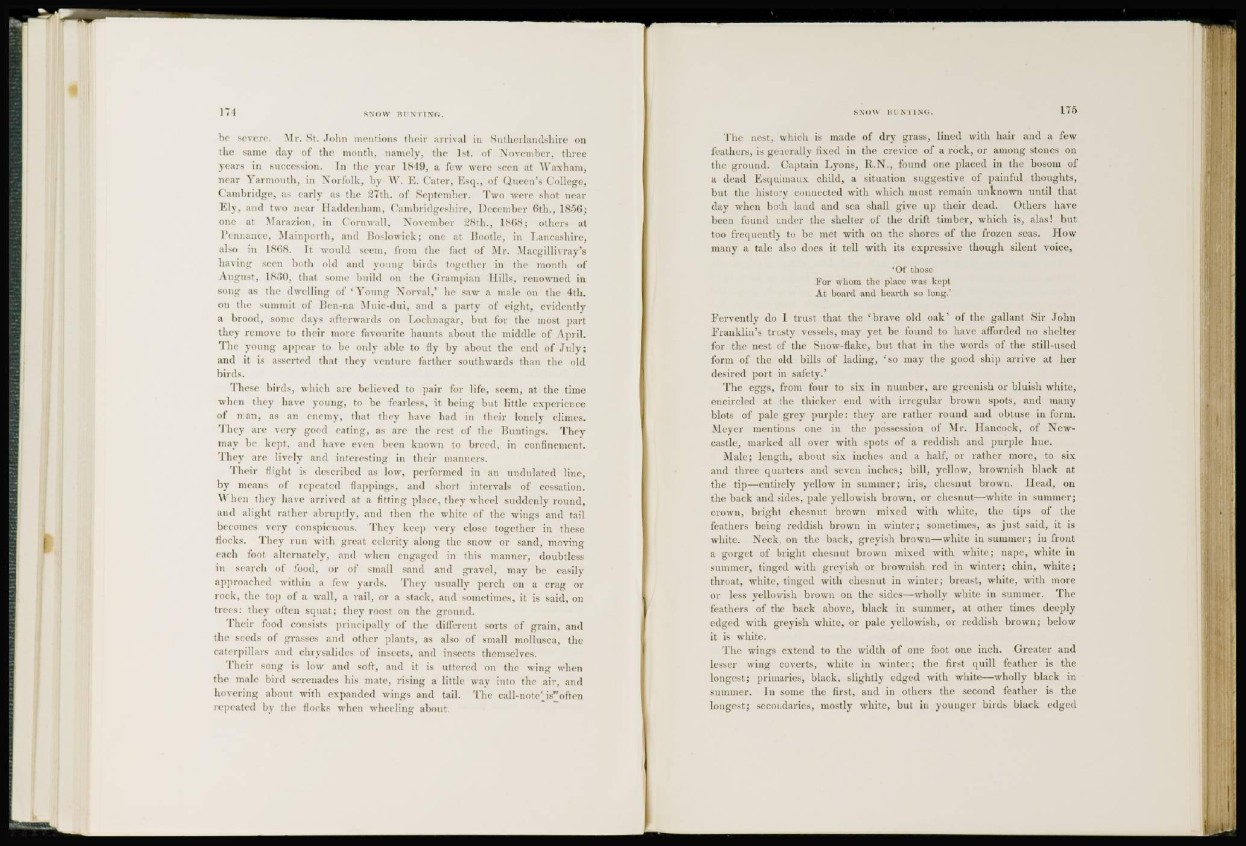
be severe. Mr. St. John mentions their arrival in Sntherlandihire on
the same day of the month, namely, the 1st. of November, three
years in succession. Tn the year 1819, a few were seen at \\ axham,
near Yarmouth, in Norfolk, by W. E. Cater, Esq., of Queen's College^
Cambridge, as early as the 87th. of September. Two were shot near
Ely, and two near Haddenham, Cambridgeshire, December 6th., 185b";
one at Mararion, in Cornwall, November 28th., 1S6'8; others at
Pen nance, Mainporlh, and Boslnwirk; one at linotle, in I ,aneashirc,
also in 1868. 11 would seem, from the fact of Mr. Macgillivray's
having seen both old and young birds together in the month of
August, 1830, that some build on the Grampian Hills, renowned in
song as the dwelling- of ' Young Norval,' he saw a male on the 4th.
on the summit of Ben-na Muic-dui, and a party of eight, evidently
a brood, some days afterwards on Eochnagar, but for the most part
they remove to their more favourite haunts about the middle of April.
The young appear to be only able to fly by about the end of July;
and it is asserted that they \ en turn farther southwards than the old
birds.
These birds, which arc believed to pair for life, seem, at the time
when they have voung, to he fearless, it being but little experience
OF nan. as an enemy, that they have had in their lonely climes.
They are very good eating, as arc the rest of the Buntings. They
may he kept, and have even been known to breed, in confinement.
Thcv are lively and interesting in their manners.
Their flight is described as low. performed in an undulated line,
by means id' repeated flappings, and short intervals of cessation.
^\ hen thcv have arrived at a fitting place, they wheel suddenly round,
and alight rather abruptly, and then the white of the wings and tail
becomes very conspicuous. Thcv keep very close together in these
flocks. They run with great celerity along the snow or sand, moving
each loot alternately, and when engaged in this manner, doubtless
in search of food, or of small sand ami gravel, may be easily
approached within a few yards. They usually perch on a crag or
rock, the top OF a wall, a rail, or a stack, and sometimes, it is said, on
trees: they often squat; they roosl on the ground.
Their food consists principally of the different sorts of grain, and
the seeds of grasses and other plaids, as also of small mollusca, the
caterpillars and chrysalides of insects, and insects themselves.
Their song is low and soft, and it is uttered on the wing when
the male bird serenades his mate, rising a little way into the air, and
hovering about with expanded wings and tail. The call-note'Js"nften
repeated by the flocks when wheeling about
NOW 111 M I M . 173
The nest, which is made of dry grass, lined with hair and a few
feathers, is generally fixed in the crevice of a rock, or among stones on
the ground. Captain Eyons, R.N., found one placed in the bosom of
a dead Esquimaux child, a situation suggestive of painful thoughts,
but the history connected with which must remain unknown until that
day when both land and sea shall give up their dead. Others have
been found under the shelter of the drift timber, which is, alas! but
TON frequently to be met with on the shores of the frozen seas. How
many a talc also does it tell with its expressive though silent voice,
'Of those
For whom the place wns kept
At hoard and hearth so long.'
Fervently do I trust that the 'brave old oak' of the gallant Sir John
Franklin's trusty vessels, may yet be found to have afforded no shelter
for the nest of the Snow-flake, but that in the words of the still-used
form of the old bills of lading, 'so may the good ship arrive at her
desired port in safety.'
The eggs, from four to six in number, are greenish or bluish white,
encircled at the thicker end with irregular brown spots, and many
blots of pale grey purple: they are rather round and obtuse in form.
Meyer mentions one in the possession of Mr. Hancock, of Newcastle,
marked all over with spots of a reddish and purple hue.
Male; length, about six inches and a half, or rather more, to six
and three quarters and seven inches; bill, yellow, brownish black at
the tip—entirely yellow in summer; iris, chesnut brown. Head, on
the back and sides, pale yellowish brown, or chesnut—white in summer;
crown, bright chesnut brown mixed with white, the tips of the
feathers being reddish brown in winter; sometimes, as just said, it is
white. Neck, on the back, greyish brown—white in summer; in front
a gorget of bright chesnut brown mixed with white; nape, white in
summer, tinged with greyish or brownish red in winter; chin, white;
throat, wdiite, tinged with chesnut in winter; breast, white, with more
or less yellowish brown on the sides—wholly white in summer. The
feathers of the back above, black in summer, at other times deeply
edged with greyish white, or pale yellowish, or reddish brown; below
it is white.
The wings extend to the width of one foot one inch. Greater and
lesser wing coverts, white in winter; the first quill feather is the
longest; primaries, black, slightly edged with white—wholly black in
summer. In some the first, and in others THE second feather is the
longe.-t; secondaries, mostly white, buL In younger birds black edged